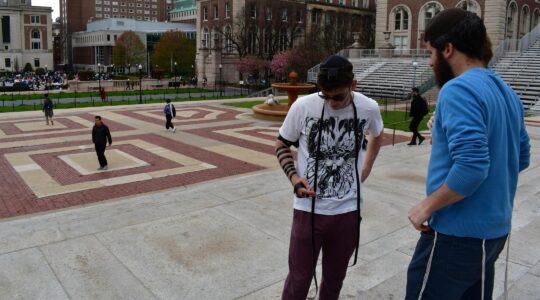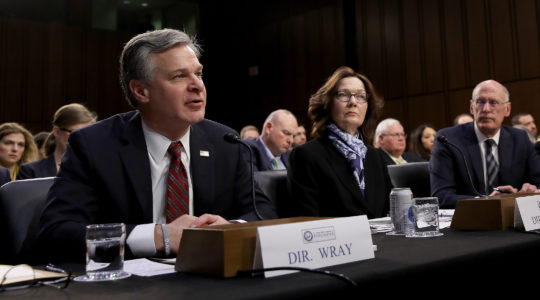SAN FRANCISCO (JTA) — Joelle Berman was shocked the first time someone suggested she wasn’t Jewish.”I was 12 or 13, and I went with a friend to a Young Judaea meeting,” says Berman, whose intermarried parents were raising her Reform in New Jersey.When the leader of the day’s program asked about her family, Berman thought nothing of saying her mother was Catholic. The Reform movement, along with Reconstructionists, considers anyone born of a Jewish mother or father to be Jewish, as long as they are being raised as Jews.But the Orthodox and Conservative movements don’t recognize patrilineal descent.The leader of the Hadassah-sponsored youth group told Berman in front of everyone that she wasn’t Jewish. She was floored.”I didn’t even know what patrilineal descent meant,” she says. “How could that be? I was studying for my bat mitzvah.”Now 23 and senior editor of JVibe, a magazine for Jewish teens, Berman says she still finds herself having to prove her Jewish credentials.”I feel I have to walk around with my Jewish resume on my sleeve,” she says. “I cite my life-cycle rituals, my Jewish camping experience, how I led a trip to Israel, how I’m editor of a Jewish magazine — is that good enough yet?”Many others are in the same situation. According to the 2000-2001 National Jewish Population Survey, 360,000 Americans aged 18 to 29 have intermarried parents.Some have Jewish mothers, others Jewish fathers. Some were raised Jewish, some weren’t. Some identify as Jewish, some don’t. Some are still trying to figure out where they belong.Despite its diversity, this population has one thing in common: It is largely ignored by the organized Jewish community.Ever since the NJPS in 1990 showed that nearly half of all new Jewish marriages involve a non-Jewish partner, the Jewish community has focused increasingly on interfaith outreach. But virtually all of that outreach is aimed at young, intermarried couples and their children.The already grown children of earlier intermarriages are very much the forgotten piece of the outreach puzzle. That’s particularly true for those older than 30, since the very few outreach initiatives that do exist focus on young adults.”It’s a population that is not on the Jewish communal radar,” says Rabbi Kerry Olitzky, executive director of the Jewish Outreach Institute.Very few Jewish federations, Jewish Family Services or synagogues make specific overtures to this group. They tend to be lumped in with the entire intermarried target audience, whether or not they are intermarried. For those who are not, programs designed for two-faith households can be irrelevant, even off-putting.”It boggles my mind that more people are not taking this up,” says Rabbi Avis Miller of Congregation Adas Israel, a large Conservative synagogue in Washington.Ed Case, president of InterfaithFamily.com, a support community for intermarried families and their offspring, wanted to create a special section on his Web site for young adults from intermarried homes. He shopped the idea to foundations and big donors, but says no one was interested in funding it.”The community is geared toward families with young children,” says Paul Golin, associate executive director of the Jewish Outreach Institute. “Whatever exists for the adult children of intermarriage is primarily grassroots initiatives of the people themselves.”Little researchNot only is there little outreach to this population, there’s precious little research on it either.The Jewish Outreach Institute commissioned a 2005 study, and Brandeis University’s Cohen Center for Modern Jewish Studies published a 2004 paper based on data from its own survey of Jewish life on college campuses and the 2000-2001 NJPS.But that’s about it. Experts say that’s largely because the numbers only recently reached critical mass.”This is the first wave of adult children from that huge rise in intermarriage that began in the 1980s,” Golin says.And the wave is growing. A 2005 survey by Hillel: The Foundation for Jewish Campus Life found that 48 percent of college students who consider themselves Jewish come from intermarried homes.That has tremendous implications for the future of the American Jewish community, says Clare Goldwater, Hillel’s associate vice president for Jewish life.”Almost half have backgrounds where they celebrate non-Jewish holidays, where they didn’t grow up with the assumption that Jewish is the only way,” she says. “They come from families with all sorts of religious and ethnic traditions.”And it’s not just those with non-Jewish mothers who feel alienated, conflicted or angry about having to explain the “other” side of their families.Laurel Snyder, 33, of Atlanta, is editor of “Half-Life,” a collection of essays by young adults like herself from intermarried backgrounds. Although she converted years ago, she still encounters awkward social moments.”Someone will say, ‘That’s a nice sweater,’ and I’m about to say that I got it for Christmas, but I don’t,” Snyder says. “I say, ‘My mother gave it to me,’ or ‘I got it for the holidays.’ “It’s not that she’s ashamed, but there remains a lingering feeling of not being considered a “real” Jew, Snyder admits.After its 2005 study, Hillel explored the idea of special programming for students from intermarried homes as part of its overall goal of becoming more welcoming and accessible. Ultimately Hillel decided against it, Goldwater says.”Everything we know from focus groups and Hillel professionals indicates that they are not interested in being singled out,” Goldwater says. “It probably makes them feel even less included.”It’s not a monolithic group, anyway, which presents a challenge for programmers.”Some fully identify as Jewish, a percentage identify as half-Jewish, and others would be offended to be called half-Jewish,” Golin says.The Jewish Outreach Institute has developed a guide for Jewish professionals to use in reaching out to the young adult children from intermarried homes. They have presented it in San Francisco and at Hebrew Union College, and are using it to help Hillel create outreach programs on four pilot campuses.The campus program won’t single out these students from any other unaffiliated group, Golin says, but it “will help Hillel create programs that avoid things they have told us are turnoffs.”For example, the guide notes that students from intermarried homes feel drawn by Jewish culture, so the suggestion is to screen Jewish-themed films in a local movie house rather than a synagogue or JCC, and hold a discussion afterward in a cafe or bistro.Many experts and young adults from intermarried homes say there are now so many of them, it’s not much of an issue, at least in their own age group.”I don’t run in circles where it comes up,” says Berman, who is active with the Kavod Jewish Social Justice House, a transdenominational center in Boston for young Jews interested in social action.”There are people from Conservative and Orthodox homes, and they would never dream of questioning my Jewish identity,” she says of the Kavod center. “We focus on more important things.”That wasn’t the case a generation ago, says Fern Chertok, co-author of the 2004 Cohen Center paper. Today’s students “know lots of other kids of intermarriage, they’re not unusual, and being Jewish is part of their hyphenated self,” one of many identities that the millennial generation takes on and off at will.For people in their 40s and older from intermarried backgrounds, however, “Judaism is more of an umbrella for their identity, more central,” Chertok says.Making connectionsSome of the young adults do want a safe place to explore their religious and ethnic questions. That’s why Jewish Family Service of Seattle got together with Jconnect Seattle, a post-college program, to run a four-week discussion class in January for young adults from intermarried families.”It’s worth it for communities to look and see if there’s a need rather than assuming there’s not,” says co-facilitator Marjorie Schnyder, director of Jewish family life education at Jewish Family Service. “People may feel welcome but still want to connect with others like themselves.”One participant was Shelly, 26, who declined to give her real name because her parents still live in the small Idaho town where she grew up. It’s a place she describes as “very narrow-minded and anti-Semitic.”Now that Shelly is an adult, she feels ready to explore her mother’s Jewish background, which the family hid after they moved to Idaho when Shelly was 10.”It’s great to hear other people’s stories and talk about how we’re going to raise our own children,” she says. “And it’s helping me connect even more with my mother.”The little research that has been done on adults from intermarried backgrounds reveals that many feel deeply connected to their Jewish cultural and ethnic heritage but have little if any involvement with Jewish ritual or institutions.In the Hillel study of college-age young adults who consider themselves Jewish, more than 90 percent of those with only one Jewish parent said they’re ethnically Jewish, but just half said they were Jewish by religion. In contrast, more than 90 percent of those with two Jewish parents said they were Jewish by religion.”Those with a non-Jewish parent are much more likely to identify as Jewish ethnically than religiously,” Goldwater says.The Jewish Outreach Institute study yielded similar findings. Interviewing 90 young adults from intermarried homes in Boston, Chicago and San Francisco, it found that very few had received any formal Jewish education, and just 30 percent considered themselves Jewish by religion.But almost 70 percent said “being Jewish” was important to them, and 78 percent said they wanted to pass along their Jewish identity to their children.Unaffiliated adults from intermarried families who want greater involvement often are hesitant to enter synagogues or other Jewish institutions, outreach experts say. But they are curious — and the movements, so eager to absorb the newly intermarried, aren’t getting the message.The Reform movement does not run programs specifically targeting the adult children of intermarried parents. Why would they need it, the thinking goes, if the movement recognizes children of one Jewish parent as Jews?But that ignores the conflicted feelings many such adults have about their dual heritage, even those raised unequivocally as Jews, as well as the fact that children don’t always follow the path laid out for them by their parents.Kathy Kahn, outreach director for the Union for Reform Judaism, estimates that 15 percent of the 75,000 people who have taken the movement’s Taste of Judaism introductory classes come from intermarried homes where they were raised as Christian, both Christian and Jewish, or with no religion.”And they’re coming back,” she says.Kahn says that shows this population, which was not raised Jewish, should not be written off.Just over three years ago, Avis Miller in Washington launched “Open Dor,” a pun on the Hebrew word for “generation,” a workshop for young adults “with mixed or non-Jewish ancestry.” She uses the workshop to funnel those interested into other Jewish education or conversion classes.Participants come from varied backgrounds. Some had parents who were Holocaust survivors and hid their Jewishness. One Mormon woman found out she was related to a founder of B’nai B’rith — the name Koon had been changed from Cohen.These experiences are a wake-up call, Kahn says.”There are some who say we should decide who to spend money on by seeing how hard their Jewish heart beats,” she says, referring to outreach that focuses on deepening Jewish connections for those already within the community.”But a person whose Jewish heart is not beating that strong now, it could happen next year, or in five years, or in 10 years. You never, never know who will find their way back.”





